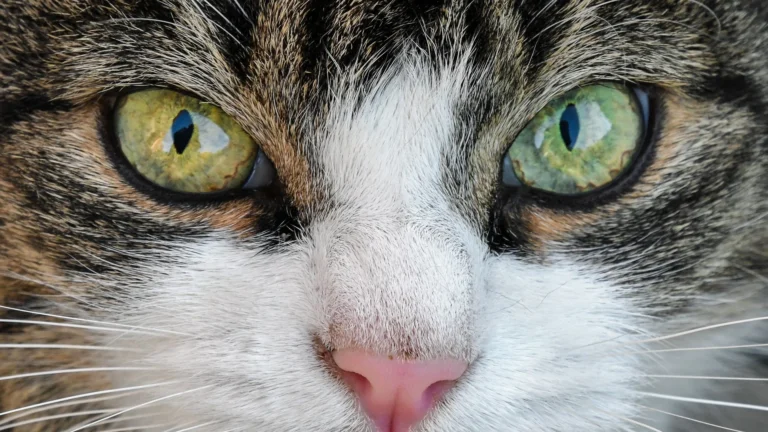Retinal Detachment in Cats – Cats are well-known for their sharp eyesight and excellent night vision. But some medical cases can cause this eyesight to fail them. Retinal Detachment in Cats is one of the common causes of blindness, and sadly, several cats will experience this situation as they age. It frequently goes hand in hand with other thorough causes, so good health management decreases the chance that your cat will ever have to experience a detached retina. But every owner needs to be on the lookout for signs of sight loss in their cat in case retinal detachment takes you by surprise.
Table of Contents
Toggle
What Is Retinal Detachment In Cats? Explain!
Retinal detachment is a situation that commonly affects older cats and cats with some basic conditions. The retina is the light-receptive layer of cells in the back of the eye that is accountable for vision. When it is subject to trauma or high blood pressure, two layers of the retina can start to separate from each other. This causes a loss of eyesight and can cause permanent blindness if left untreated. Partial retinal detachment appears when only a small part of the retina is separated. Total retinal detachment can also occur, causing complete blindness. Frequently, retinal detachment continues, starting with partial detachment and worsening with time, however, this can be over a short period.
This detachment can appear in one eye or both eyes. However, most types of retinal detachment are at least partially treatable if seen quickly, so proper diagnosis is key to helping your cat recover eyesight. In some cases, treating the basic cause will let your cat’s retina heal on its own. In serious cases, surgery might be important to repair damage to the eye. Discussing with your vet will aid you in deciding what the best treatment is for your cat.
Causes Of Retinal Detachment In Cats
- Retinal detachment is led to altered pressures to, or in, the eye. This pressure is often caused by redness or trauma to the eye.
- Another basic cause is hypertension or high blood pressure. Hypertension can lead the blood vessels of the eye to leak and apply pressure on the retina.
- Kidney diseases, tumors, hyperthyroidism, and endocrine diseases can cause retinal detachment as well.
- Another cause of retinal detachment is congenital weakness. Some cats are born with some defects in the eye that cause an extra possibility of retinal detachment. Congenital defects may cause detachment starting at birth, or it might enhance the chance of detachment later in life.
- The final main cause of retinal detachment is trauma to the eye. An eye injury can cause quick retinal detachment.
- In some conditions, a wound to the part around the eye can lead to detachment because of puffiness or infection, even if the eye itself is not visibly injured. This detachment might not appear instantly.
In some conditions, surgery to eye surgery can lead to a change in pressure, leading to retinal detachment. It is essential to see your cat carefully after cataract or glaucoma surgery in a situation where retinal detachment could appear at any point in the healing process. However, for some cats, there is no basic cause for the retinal detachment found.
Signs of Retinal Detachment in Cats
Retinal detachment in cats is only visible to vets with an ophthalmoscope, however, some signs can alert you to an issue. Changes in behavior might tip you off to weakening vision caused by a detached retina. Look for signs of blindness, like bumping into things, head bobbing, less movement, startling more easily, or tripping frequently. If your cat is going through detachment in one eye, you might see that your cat startles more effortlessly when approached from one side. Another basic tip-off to sight loss is eyes that are dilated diversity or that are completely dilated and do not react casually with changes in light. Owners may see that there seems to be blood in the eye or that the pupil looks pale rather than black. Because retinal detachment is frequently caused by basic conditions, a diagnosis of a common condition should put you on the alert for signs of vision loss. Blood tests, blood pressure measurement, and eye pressure may also be required to be checked. Understanding any medical history that might make retinal detachment more prone can aid your vet in making a diagnosis as well.
Conclusion
Retinal detachment is a severe but treatable situation that various cats experience as they age. It can frequently be treated by handling basic causes, but in some conditions, surgery is essential to care for your cat. If the case is left untreated for too long, permanent damage will occur. Because of this, it is essential to be alert and aware of possible eyesight changes in your cat, particularly if they are at higher risk of retinal detachment. Take veterinary suggestions straight away if you think your cat is losing their eyesight.
FAQs
Can cats see things with detached retinas?
In some cases, complete and proper veterinary treatment can bring back partial eyesight to a cat with a retinal detachment, but in most conditions, permanent blindness will result.
How do veterinarians treat retinal detachment in cats?
Some surgical techniques are available to reattach the retina, and some techniques can help in the regeneration of retinal tissue. However, if surgery is found unnecessary, your veterinarian will treat the basic medical cause of the retinal detachment by suggesting your cat’s medication.
Will a cat’s eye be treated on its own?
Some eye infections in cats will heal on their own. However, it is essential to get a diagnosis from a veterinarian and follow their suggestions.
How to know if a cat is losing its eyesight?
Disorientation and bumping into objects, specifically in low light. Walking slowly or carefully with their legs wider apart than usual. Having difficulty in finding familiar things like food bowls and litter trays.





